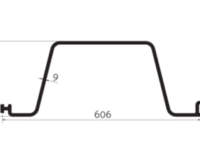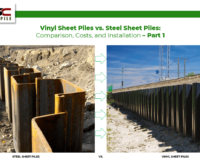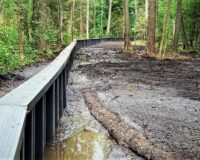Small retention, which involves collecting water in small natural and artificial reservoirs as well as in river networks and drainage ditches, plays an important role in shaping a microclimate. Its main goal is to increase the level of groundwater, consequently moisturizing natural habitats. This directly translates into increased biodiversity of fauna and flora, reduction of greenhouse gas emissions, improvement of agricultural practices, and more efficient use of rainwater, for example, for watering gardens. Traditionally, wood, concrete, stone, or steel are used for these purposes, but modern solutions such as vinyl sheet piles provide a durable, ecological, and economical alternative. Integrating these products with green infrastructure and local initiatives for subsidizing private projects is becoming increasingly important in the context of sustainable water resource management.
What is Small Retention?
Small retention involves the construction of new water reservoirs or the erection of dams on existing ones to slow down water runoff and increase retention capacity. The reconstruction of water networks and the protection of wetlands and peatland ecosystems from drainage help increase the soil’s ability to store water. Small damming structures, such as water thresholds, barrages, and sluices, help maintain water level differences. These structures also play a role in stabilizing the bottom, silting up deep watercourses, and leveling the slope of the riverbed. When designing small retention structures, it is worth considering alternative solutions that, in addition to durability and attractive pricing, are environmentally friendly due to their low carbon footprint and complete neutrality to drinking water.
What Distinguishes Green Infrastructure?
 We can say that small retention is a part of a larger approach, which we broadly describe as Green Infrastructure, a strategic move to managing natural resources that integrates the protection of the natural environment and ecosystems with the needs of society and urban development. It is a network of natural and semi-natural areas, including green and water areas, which together form a cohesive and integrated system within the urban and rural landscape. Green infrastructure plays a key role in water resource management.
We can say that small retention is a part of a larger approach, which we broadly describe as Green Infrastructure, a strategic move to managing natural resources that integrates the protection of the natural environment and ecosystems with the needs of society and urban development. It is a network of natural and semi-natural areas, including green and water areas, which together form a cohesive and integrated system within the urban and rural landscape. Green infrastructure plays a key role in water resource management.
Examples of such infrastructure may include green roofs that absorb rainwater, wetlands acting as natural water filters, and small retention reservoirs that collect and gradually release water, preventing floods and contributing to the restoration of local hydrological cycles. Green infrastructure brings a range of benefits to society and the environment, such as improving air quality, lowering temperatures in cities, increasing biodiversity, and improving the well-being and health of residents. By providing natural pathways for wildlife and flora, green infrastructure helps maintain biodiversity and positively impacts ecosystems.
In the context of green infrastructure, vinyl sheet piles can be used to create small retention basins, construct small retention structures, rain gardens, or watertight barriers in the ground that reduce groundwater runoff from areas prone to excessive drying. Due to their durability and minimal environmental impact, they are an important element of green infrastructure, enabling harmonious coexistence of urban development with the natural environment. The raw material used in their production is resistant to corrosion and UV radiation. A certificate issued by the National Institute of Public Health confirms that the material of the sheet piles does not affect the parameters of drinking water.
Water Barrages
A water barrage is a structure protruding above the waterbed, with the same elevation on both sides. Barrages not only raise the low water level but typically block the movement of sediments carried along the bottom. The height of the overflow should not exceed 1’ to avoid hindering the migration and flow of fish. A barrage is a structure with a fixed crown, without the possibility of adjusting the level of damming.
Water Thresholds/Barriers
Small Vinyl Retention Sluices
A retention sluice is a damming hydraulic structure located in the watercourse bed, equipped with closures that allow for water level regulation. Retention sluices enable water to be dammed up to the required level at a given moment. Such hydraulic structures consist of a wall crossing the watercourse bed, in which there is an opening equipped with special beams that serve as closures. They are movable parts of the structure, enabling the regulation of the water level in the watercourse from the upper water side
 Small Vinyl Retention Sluice installed in 2017
Small Vinyl Retention Sluice installed in 2017
Rain Gardens
The Role of Small Retention in Counteracting Flash Flood Phenomenon
Local Initiatives for the Development of Green Infrastructure
Local initiatives and funding programs are key to promoting green infrastructure, aiming to reduce the impact of urbanization on the environment. The goal is to create ecosystems that support biodiversity and water retention, such as rain gardens or green roofs. Funding includes grants, tax breaks, and technical support. Cross-sector cooperation is important for implementing integrated ecological solutions. These initiatives have a long-term impact, increasing the resilience of cities to climate change and improving the quality of life of residents. They are the foundation for building sustainable, ecological urban communities.Local Initiatives for the Development of Green Infrastructure
Summary
Small changes, as part of a larger strategy, can consequently contribute to a significant improvement in the quality of life and existence closer to nature. These actions are also often supported by local government programs aimed at developing green infrastructure, through co-financing projects of private individuals who want to change their immediate environment for the better.
Author: David Jasinksi I Email: david@escvinylpile.com









